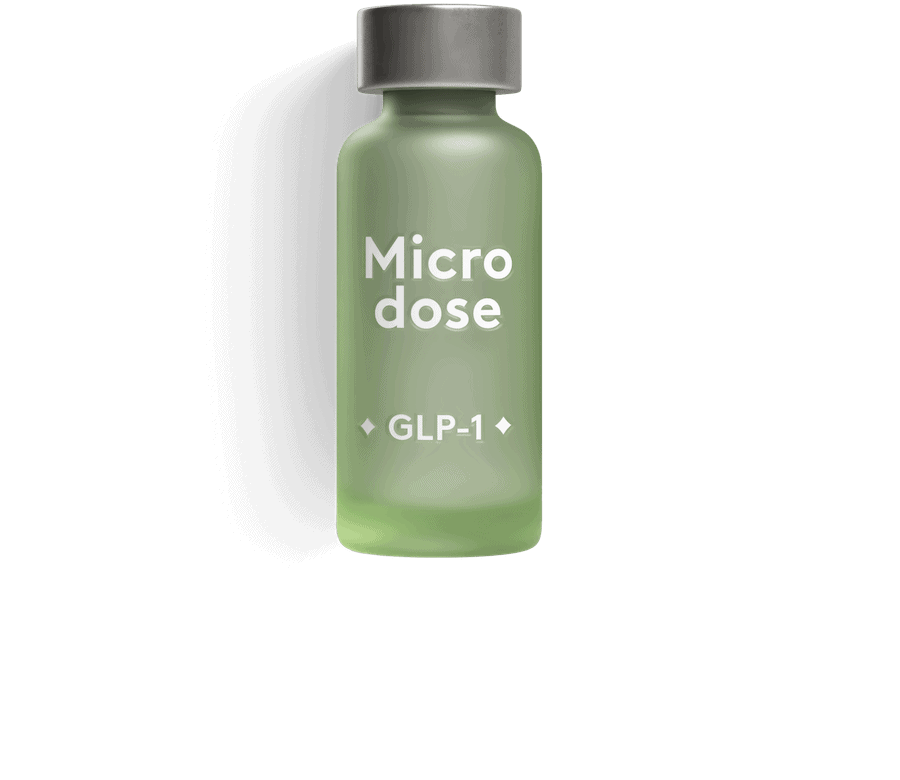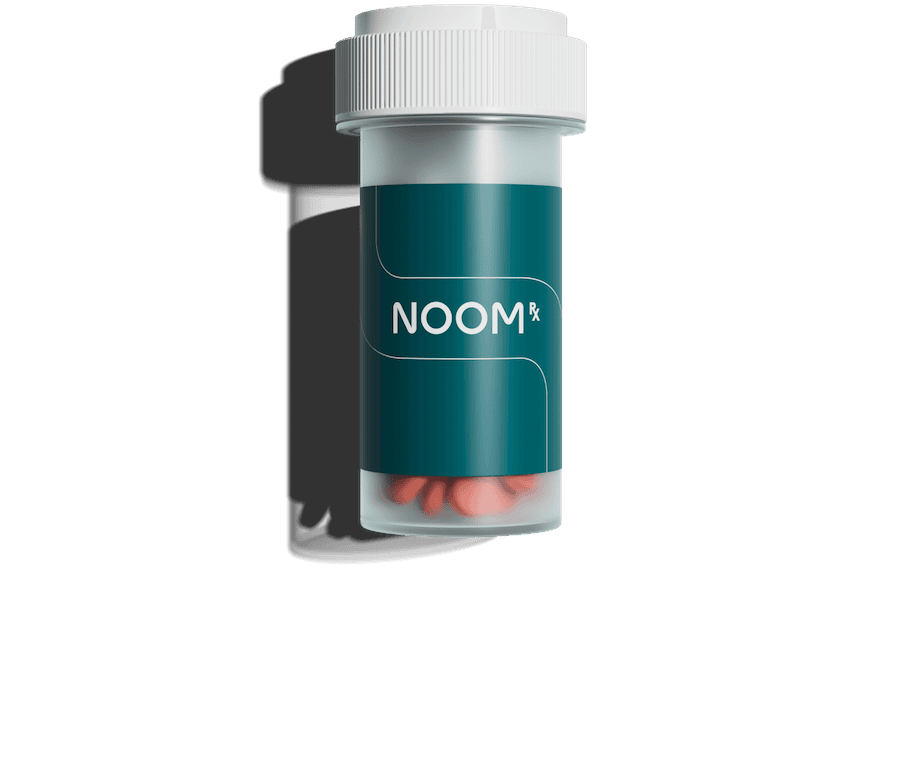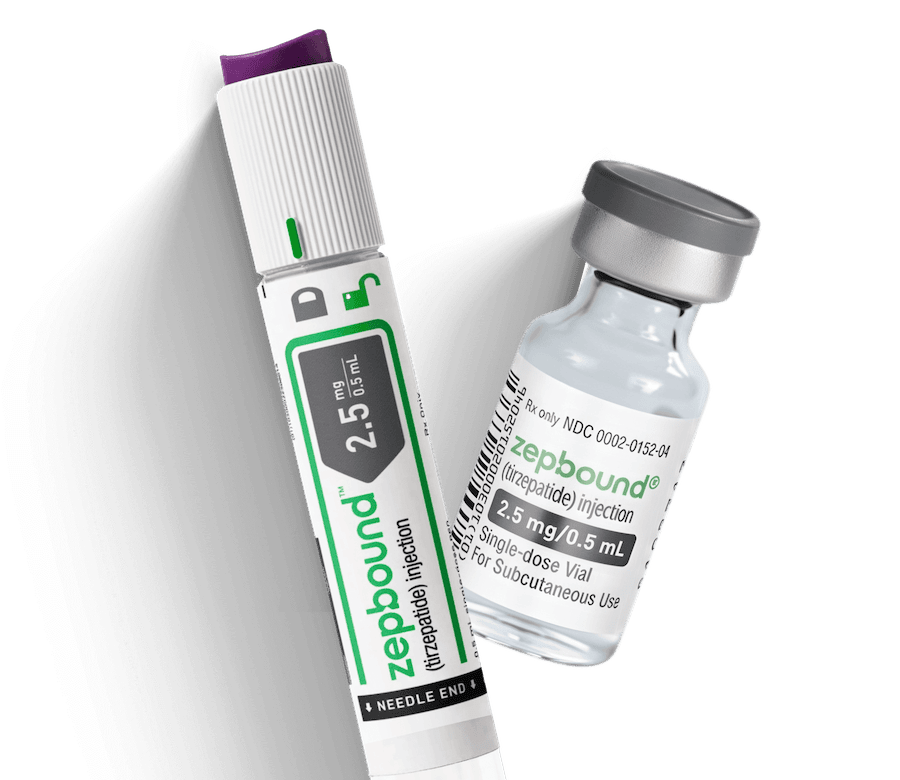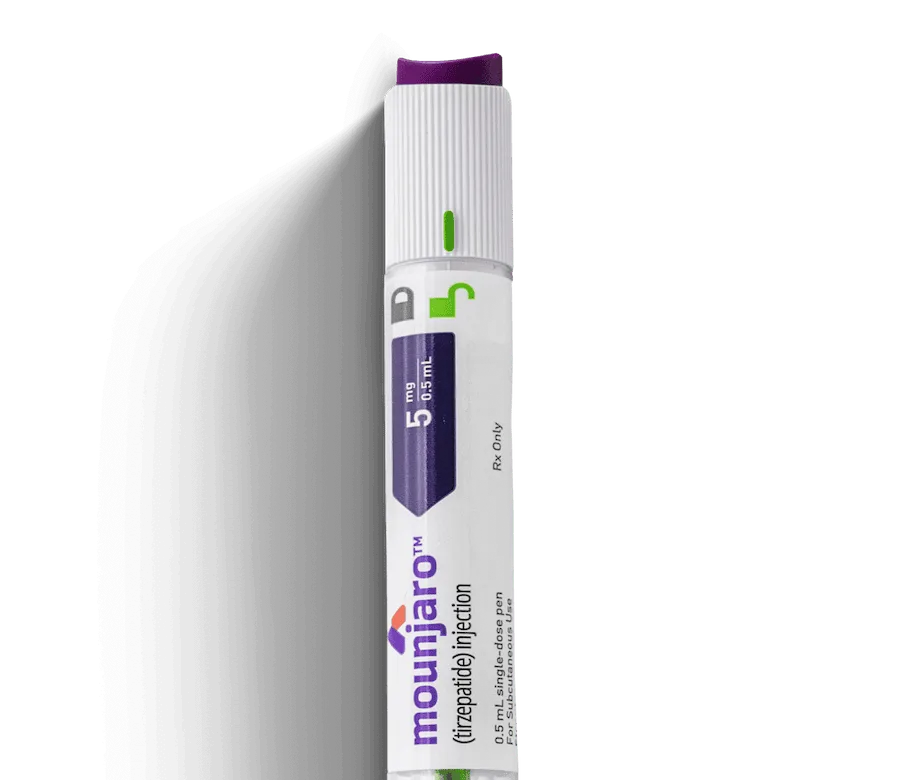- What is phentermine?
- How phentermine is taken for weight loss
- Dosage adjustments & personalization
- How much weight can you lose with phentermine?
- Cost and insurance
- Side effects and safety considerations
- Phentermine vs. GLP-1s
- FAQs about phentermine and weight loss
- The bottom line: Phentermine and weight loss
What you’ll learn:
- Phentermine is a prescription appetite suppressant pill that can make it easier to follow a lower-calorie diet.
- Phentermine is FDA-approved for short-term weight loss, up to 12 weeks, but can be used off-label for longer.
- It is one of the medications in Qsymia®, an FDA-approved weight loss medication for longer-term weight management.
Long before GLP-1 medications like Wegovy® and Zepbound® entered the weight loss medication market, phentermine was established as a prescription for helping people lose weight. You might remember it as one of the active ingredients in Fen-Phen, which was taken off the market in the late 90s.
Phentermine is a stimulant that is designed to help with weight loss by suppressing appetite. It has a long history, having been approved for weight loss in 1959 for short-term weight loss, about 12 weeks. It’s available both as a standalone prescription and in combination with topiramate as Qsymia®, an option FDA-approved for longer-term weight management.
Let’s explore what phentermine is, how it works, and the different formulations available. We’ll go through how it works alone and in the medication Qsymia®. Plus, how it’s taken, expected results, safety considerations, and how it compares with newer GLP-1 medications.
What is phentermine?
Phentermine is a stimulant that affects the central nervous system. It increases the release of neurotransmitters like norepinephrine, leading to a reduced appetite. This helps reduce hunger signals, making it easier to maintain consistent, healthier eating habits and lower the number of calories consumed, leading to weight loss.
As mentioned, phentermine is used for weight loss in two main ways:
- On its own: Phentermine is FDA-approved for short-term use, typically a few weeks, to support weight reduction alongside diet, exercise, and behavior changes. The limit to short-term use dates back to its original approval in 1959, when long-term safety data weren’t available. Since then, newer studies have suggested that taking phentermine for longer than 12 weeks can be safe and effective for some people, but this is considered off-label and depends on your provider’s guidance.
- As Qsymia®: Phentermine is one of the two active ingredients in Qsymia®, an extended-release medication approved for weight management. The other ingredient is topiramate. Learn more about how much weight you can lose with Qsymia, and find out more about the side effects of Qsymia.
Types of phentermine
Phentermine is available in both brand-name and generic versions, most commonly as tablets or capsules.
Brand
- Lomaira® was introduced as a lower-dose option of phentermine to allow for more personalized dosing. At 8 mg, it can be taken up to three times daily before meals, helping spread appetite control across the day. This approach lets providers tailor treatment to the lowest effective amount. Lomaira® itself doesn’t have a generic equivalent on the market.
- Qsymia® offers a longer-term weight loss solution than short-term phentermine use. It combines phentermine with topiramate in a single capsule, designed for once-daily dosing. This combo not only supports appetite control but also helps with satiety, making it easier to maintain progress.
Generic
- Generic phentermine is available in tablets, capsules, or disintegrating tablets, with strengths of 15 mg, 30 mg, and 37.5 mg. These are usually taken once daily in the morning. Adipex-P®, a brand-name version, used to be widely prescribed but was discontinued in June 2025. Today, only generics remain, prescribed in the same strengths and taken in the same way.
How phentermine is taken for weight loss
Phentermine doesn’t follow a slowly escalating dose approach like some other weight loss medications, like Wegovy® and Zepbound®. Instead, your provider’s goal is to find the smallest dose that still gives results. That could mean adjusting between tablet and capsule, or splitting doses as needed and prescribed.
Here’s a quick overview of phentermine formulations and dosage strengths:
| Dosage strengths | Availability | Typical use |
|---|---|---|
| 15 mg, 30 mg, 37.5 mg tablets or capsules | Generic only | Taken once daily before breakfast or 1 to 2 hours after. The 37.5 mg dose may be split into half doses (18.75 mg) if recommended by your provider. |
| 15 mg, 30 mg, 37.5 mg orally disintegrating tablets (ODTs) | Generic only | Dissolved on the tongue once daily in the morning, with or without water. |
| 8 mg tablets | Lomaira® (no generic) | Taken three times daily, about 30 minutes before meals. Some people may take half a tablet (4 mg) if directed. |
Qsymia dosage strengths
Each dose of Qsymia combines phentermine and topiramate. The dosage strengths are expressed as the amount of each drug in milligrams (mg), with the phentermine listed first and the topiramate listed second.
| Dosage strengths | Availability | Typical use |
|---|---|---|
| 3.75 mg/23 mg, 7.5 mg/46 mg, 11.25 mg/69 mg, 15 mg/92 mg (phentermine/topiramate ER) | Brand (Qsymia®) and generic | Once daily in the morning; dose is titrated based on response and tolerance. |
Phentermine: Dosage adjustments & personalization
Your provider may adjust your phentermine dose depending on how your body responds and your overall health. Here are a few common reasons why a dose might be tailored, according to the prescribing info:
- Weight and side-effect tolerance: Some people may respond well to a lower dose (like half a tablet), while others may need the full amount. If side effects like restlessness or insomnia are a problem, your provider may lower the dose or change when you take it.
- Age: Older adults are often started on the lowest dose, since they may be more sensitive to side effects.
- Kidney function: Because phentermine is cleared through the kidneys, those with reduced kidney function may need a lower dose or closer monitoring.
If you notice your symptoms aren’t improving, or the side effects outweigh the benefits, it’s a sign to check in with your healthcare team.
Qsymia dosing
Unlike phentermine, which is typically prescribed at a set dose, Qsymia follows a dose-escalation pattern. Treatment begins with the lowest strength, and the dose is gradually increased over time depending on how well it’s tolerated and how much weight loss is achieved.
This step-up approach helps minimize the potential side effects of Qsymia® and gives your body time to adjust. Many people do well on the standard maintenance dose, but your provider may adjust it higher if weight loss goals aren’t met. Read more about how your doctor will find the right dose of Qsymia for weight loss.
How much weight can you lose with phentermine?
On its own, phentermine is usually seen as a short-term tool to help jumpstart weight loss. When paired with healthier eating habits and regular activity, people who took phentermine for up to 12 weeks lost about 5% of their starting weight on average. That’s roughly 10 pounds for someone starting at 200 pounds.
With Qsymia®, which combines phentermine and topiramate in an extended-release capsule, results are typically more significant. In a clinical trial, people taking the highest approved dose lost an average of 10% of their starting weight after about a year.
Phentermine and Qsymia: How long does it take to see results?
Studies show weight loss usually begins within the first weeks.
Phentermine is designed for short-term use. Your provider will help decide if it’s the right fit for your health goals and how it fits into a broader plan.
For longer-term weight loss, Qsymia is an option. Clinical trials have shown that many people begin to see meaningful weight loss as early as 8 weeks, with results continuing to build over the course of a year.
Rx weight loss, the right way, with Noom
Get access to prescription weight loss medication with Noom.Phentermine: Cost and insurance
Phentermine is available as both brand-name and generic prescriptions, and your total cost can vary based on which version you’re prescribed, your pharmacy, and whether your insurance covers it.
Here’s what current retail prices look like on average for a monthly supply, based on GoodRx data:
- Generic phentermine (15 mg, 30 mg, or 37.5 mg tablets/capsules): $37–$41
- Lomaira™ (8 mg tablets): $28
- Qsymia® (phentermine/topiramate ER): $150
- Generic Qsymia® (phentermine/topiramate ER): $60–$200
Is phentermine covered by insurance?
Some health insurance plans may cover phentermine, but it isn’t common for weight loss to be covered. Check with your plan or contact your provider directly to confirm if phentermine is included and what restrictions might apply.
Can you save on phentermine with manufacturer discounts?
Yes. The Lomair Lo-Cost Access Program keeps treatment affordable by capping the price at no more than 50 cents per tablet, whether or not you have insurance, as long as you meet the program’s eligibility requirements:
- Prescription must be for Lomaira (no substitutions)
- Minimum 30-tablet fill required
- Accepted at most U.S. pharmacies
- Available only to residents of the U.S., D.C., Puerto Rico, Virgin Islands, or Guam
- Not valid if Lomaira is reimbursed in full by a third-party payer
- People using Medicare Part D may use the card if paying the full cash price, and no claim is submitted to Medicare
Pharmacy discount services or coupons can also lower the price of generic phentermine at retail pharmacies, which may be helpful if your insurance doesn’t cover it or if you’re paying cash.
Phentermine: Side effects and safety considerations
Phentermine can come with side effects, most of which are mild and temporary, especially in the first days or weeks, but some can be more serious and need quick medical attention.
Most common side effects of phentermine
The most common side effects of phentermine include dry mouth, unpleasant or metallic taste, constipation, diarrhea, nausea or vomiting, difficulty sleeping, restlessness, dizziness, tremor, and sometimes headaches. These effects are usually manageable, especially when you follow your provider’s guidance on timing and dosage.
Serious side effects and warnings
While most people taking phentermine experience only mild, temporary side effects, there are rare but more serious reactions that require immediate medical attention.
- Increased blood pressure and heart rate: Call your doctor if you notice a consistently fast heartbeat, palpitations, or elevated blood pressure that doesn’t go away.
- Chest pain or shortness of breath: Seek immediate care if you develop chest pain, trouble breathing, or swelling in the legs or ankles.
- Difficulty with exercise tolerance: If you feel unusually tired, get winded easily, or notice a drop in stamina with activities you could previously handle, let your provider know right away.
- Severe restlessness, agitation, or mood changes: Report extreme nervousness, irritability, or sudden mood changes promptly to your doctor.
- Insomnia or persistent trouble sleeping: If sleep problems interfere with daily life, your provider may need to adjust or discontinue your dose.
- Allergic reactions: Rash, itching, swelling, dizziness, or trouble breathing require urgent medical attention.
- Potential for misuse or dependence: Signs of dependence may include feeling unable to function without the medication, taking more than prescribed, or cravings for the drug. Contact your provider immediately if you notice any of these behaviors.
Always inform your doctor about any other medications or supplements you take. If you notice new or unusual symptoms, check in with your provider promptly. They can adjust your dose or explore alternatives if needed.
Who shouldn’t take phentermine?
Phentermine isn’t right for everyone. Before beginning treatment, inform your doctor if you have:
- Heart problems: If you have a history of heart disease, uncontrolled high blood pressure, stroke, or irregular heart rhythms, you shouldn’t take phentermine.
- Eye conditions: Avoid phentermine if you have glaucoma, since it can increase eye pressure.
- Thyroid disorders: People with an overactive thyroid (hyperthyroidism) shouldn’t use phentermine.
- Recent MAOI use: If you have used a monoamine oxidase inhibitor (MAOI) antidepressant in the last 14 days, you shouldn’t take phentermine.
- Allergies to phentermine: People who are allergic to phentermine or any of its ingredients can’t take it.
- People who are pregnant or breastfeeding also can’t take phentermine.
Overdose risks and symptoms
Phentermine should only be used exactly as prescribed. Taking excessive amounts can result in serious, potentially life-threatening effects. Both acute (sudden) and chronic (long-term) overdoses have distinct signs to watch for.
Symptoms of acute overdose may include:
- Restlessness, tremors, or shaking
- Rapid breathing or hyperactive reflexes
- Confusion, panic, hallucinations, or aggressive behavior
- Fatigue or depression after overstimulation
- Fast or irregular heartbeat, high or low blood pressure, or even circulatory collapse
- Nausea, vomiting, diarrhea, or abdominal cramps
- Severe cases can lead to convulsions or coma
Chronic overdose may show up as:
- Persistent insomnia and irritability
- Hyperactivity or personality changes
- Psychosis that can resemble schizophrenia
- Severe skin reactions
What to do if overdose is suspected:
Call the poison help line at 1-800-222-1222 right away. If the person collapses, has a seizure, has trouble breathing, or can’t be awakened, call 911 immediately.
Phentermine vs. GLP-1s: How weight loss results compare
If you’re weighing the differences between phentermine, Qsymia, and GLP-1 medications, the outcomes can look very different depending on dose and treatment length. Here’s a look at how they compare in clinical studies:
| Medication | Study length | Average weight loss |
|---|---|---|
| Phentermine – 37.5 mg | 12 weeks | 5% |
| Phentermine/topiramate ER – 15 mg / 92 mg (Qsymia®) | 56 weeks | 10% |
| Semaglutide – 2.4 mg (Wegovy®) | 68 weeks | 15% |
| Tirzepatide – 15 mg (Zepbound®) | 72 weeks | 21% |
| Liraglutide – 3 mg (Saxenda®) | 56 weeks | 6% |
Phentermine can be helpful for short-term weight loss, but medications like Qsymia® and the GLP-1s are generally taken for longer and tend to produce more substantial results over time.
Deciding which option makes sense usually depends on:
- Your health background
- How long you’re comfortable staying on treatment
- The type of treatment you’re comfortable with, injections or pills
- Side effects
- Cost and insurance coverage
Frequently asked questions (FAQs) about phentermine
These frequently asked questions cover the most common concerns people have about using phentermine safely and effectively.
Does phentermine burn fat?
Phentermine is primarily an appetite suppressant rather than a medication that increases your metabolism. It helps reduce hunger by affecting brain chemicals that control appetite, making it easier to stick to a lower-calorie eating plan.
Can you drink alcohol while taking phentermine?
It’s best to avoid alcohol while taking phentermine because the combination can increase side effects. Both phentermine and alcohol affect your central nervous system, and combining them can lead to increased dizziness, drowsiness, and difficulty concentrating. Talk with your healthcare provider about alcohol use before starting phentermine.
What happens if you miss a dose of phentermine?
Take it as soon as you remember, unless your next dose is coming up soon. In that case, just skip your missed dose entirely and continue as normal.
How long can you safely take phentermine?
Phentermine is typically prescribed for up to 12 weeks. Its original FDA approval in 1959 did not include long-term safety data, and concerns remain about stimulant-related side effects such as increased blood pressure, rapid heart rate, insomnia, and potential dependence. Newer studies suggest that longer use may be both safe and effective for some people. This hasn’t been added to the official labeling, so any extended treatment is left to a doctor’s judgment and close monitoring.
Can you stop taking phentermine at any time?
Yes, but always let your provider know if you plan to stop. They may want to check in on your progress and overall health.
Can you take phentermine with Ozempic®?
There isn’t much research on using phentermine and Ozempic® together. Some providers may consider it in specific situations, but because both affect weight and appetite in different ways, it should only be done under medical supervision with close monitoring.
What kind of diet and exercise plan works best with phentermine?
The best results come from pairing it with a balanced eating plan and regular activity. Your provider may also suggest simple behavioral changes to help keep weight off.
Can I lose more weight with Qsymia® or phentermine?
Qsymia®, which combines phentermine with topiramate, has been shown in studies to help people lose about 10% of their body weight after a year on treatment. That’s generally more than what’s expected with phentermine alone. It also comes with additional considerations for safety and side effects. The better option depends on your health history, goals, and how you respond to treatment.
Sign up for Noom Digest!
Stay on top of your wellness journey with the latest Noom news, thoughtful articles, and a healthy dose of inspiration delivered right to your inbox.The bottom line: Phentermine and weight loss
Phentermine has been a part of weight loss treatment for decades, long before today’s GLP-1 medications entered the picture. As a short-term appetite suppressant, it can help people jumpstart weight loss when combined with healthy eating and regular activity. Qsymia®, the extended-release combination of phentermine and topiramate, offers a longer-term option with generally greater results than phentermine alone.
Still, phentermine isn’t for everyone. Its use is usually limited to a few weeks, and while newer studies suggest it may be safe for longer in some cases, that decision requires close medical supervision. Side effects, cost, and your overall health all factor into whether phentermine, Qsymia®, or a newer GLP-1 medication makes sense for you.
The best approach is the one that fits your health background, preferences, and long-term goals—always with your provider’s guidance. If you’re considering weight loss medication, see if you qualify for Noom Med. You’ll be paired with a clinician who can access your eligibility and goals, find the right medication for you, and prescribe it if needed.
Why you can trust us
At Noom, we’re committed to providing health information that’s grounded in reliable science and expert review. Our content is created with the support of qualified professionals and based on well-established research from trusted medical and scientific organizations. Learn more about the experts behind our content on our Health Expert Team page.













